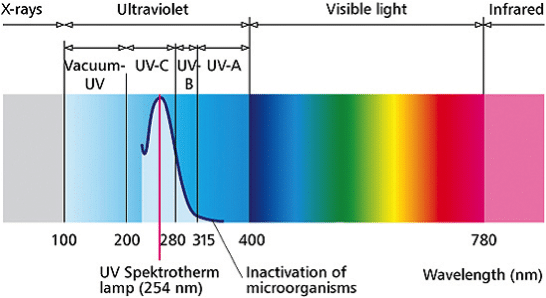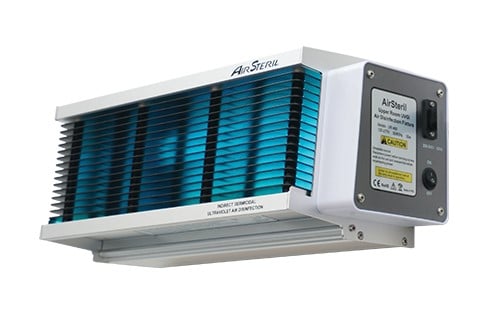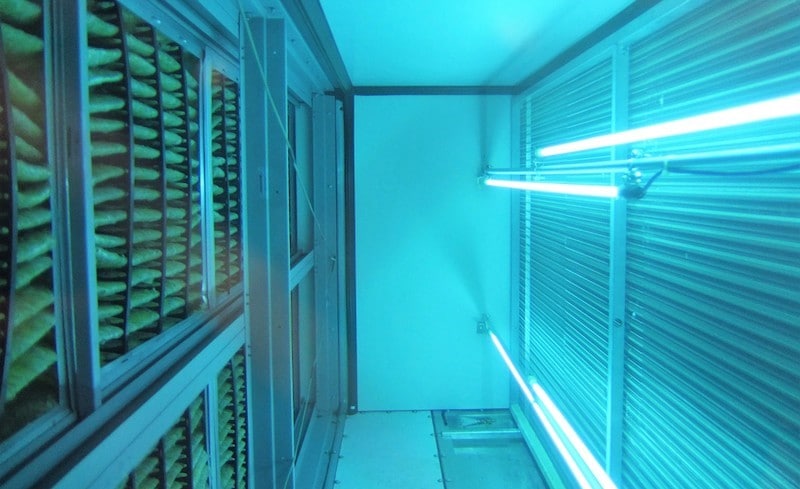The importance of a healthy workplace in now a top priority as businesses seek to operate safely during the COVID-19 pandemic. Clinics and hospitals around the world utilize ultraviolet (UV) light to kill pathogens like tuberculosis (TB), which stills run rampant in parts of the world. UV light can also be effective at inactivating viruses like the coronavirus and influenza, but only when properly implemented. There are many scientific and design principals you must consider when using ultraviolet light to effectively disinfect workplaces.
Which Type of UV Light Kills COVID-19?
Ultraviolet light comes in 3 spectra ranges:
- A (400-315 nm)
- B (315-280 nm)
- C (280-100 nm)
UV-B can kill some pathogens, but it is not super effective, ~20% effective more or less.
UV-C is what you need to really kill pathogens like COVID-19, influenza, or TB. Most of the UV-C effectiveness research comes from clinics and hospitals using it for preventing transmission of TB in areas of the world where it is still a daily occurrence.
The consensus is that 254-nm is the ideal wavelength, although there’s on-going research looking into 222 nm at Columbia University. It is less harmful to humans, and could be an option in higher concentrations to have the same effectiveness.
Are LED UV Light Wands Effective?
The UV light wands that you or I could buy online to inactivate COVID-19 are at best a pain in the butt to use properly and at worst a hot pile of garbage. Here’s why.
LEDs Are Not Good UV-C Light Sources
They can put out some UV-A and UV-B, but their UV-C output is minimal at best. The best UV-C emission for the energy buck are our old favorites – fluorescent light and high intensity discharge lamps. What’s old is new again…
Effectiveness Depends on Adequate Time and Exposure
Our good ol’ buddy Louis Pasteur demonstrated the killing harmful pathogens requires weighing exposure duration and dosage. This is the same principal applied to cooking a 140°F chicken breast using the sous vide method. As such, small, handheld, LED, battery-powered devices (low dosage) need to be oriented toward an infected surface for 10 seconds (long duration). Let’s think about real world applications.
Cell Phones
Your cell phone, roughly 2.5 inches by 4 inches can probably be disinfected in a 10 second splash front and back. 20 seconds total.
Keyboards
Your keyboard, again using your handy dandy wand, is probably going to take at least 30 seconds. Double that if you touched the back…
Desks
Your desk surface is going to take a lot longer with a wand. Likely 10 minutes. Wait, you might say. What if I pull the wand back far enough such that it can cover the entire surface?
Nope! The inverse square law works against us here. The intensity of a radiation source (dosage – remember?) drops off with the inverse square of the distance. That means it would take even longer if your wand was further away. Ack!
Doorknobs
You may say “Okay, well, dumb for a desk, but doorknobs are great. Just hit a doorknob for 10 seconds. Bingo bango.”
Nuh-uh. Doorknobs are not flat. We wrap our hands around doorknobs and UV-C emitters are most effective when there is direct line of sight between the emitter and the infected surface. You would need to re-orient your wand multiple times to get good coverage of a standard, ADA-compliant doorknob.
Other Concerns Around LED UV Light Wands
Lack of Regulation
LED wands are only very lightly regulated by the FDA and FCC. Intensity and dosage are not well quantified nor is there a good industry standard for these consumer electronic devices. That alone should give anyone pause before recommending such devices for such a serious matter as disinfection for COVID-19.
Directional Disinfection Requirements
Okay, James, we hear you, the wand is a bad idea. But check this out. Take the old iPod dock off of DJ Roomba and replace it with a UV-C light source. Then let it tear up all the pathogens after-hours.
Remember, UV-C (and light in general) is directional. UV-C is not a cloud of Lysol that envelops the room. It is a directional blast. Anything that would shade a surface, prevents the surface from being disinfected. That means papers, books, coat racks, open doors, closed doors – all could prevent UV-C light from reaching hazardous pathogens.
Health-Hazards from Exposure to UV-C Light
UV-C light is generally cancerous when exposed to live tissues. Yes, dead skin cells will absorb UV-C, but thinner areas like a wound or scab, or even a place you scratched recently, can create a gap in in your defenses and result in erythema, e.g. sunburn. Eye exposure is even worse. There are currently no consensus-based standards for mitigating the risk of exposure or for designing UV-C wands for use by consumers. Belgium has gone so far as to ban UV-C for use outside of hospitals until proper safety standards can be established. Occupational Safety and Health Administration (OSHA) does not establish UV light exposure limits. California’s OSHA program only establishes minimal UV light exposure limits. All of this is to say – UV-C light exposure is known to be dangerous and a clear application methodology for short term exposure for disinfection hasn’t been established; therefore, use of UV-C lighting in these applications opens facility owner and operators to legal liability.
Disinfecting Workplaces with UV-C in Air Handlers
UV light application in air handlers is possibly a good idea but may not be super useful for several reasons.
High Air Volume Requires High UV-C Dosage
Again – no LEDs here. The high air volume means your UV-C dosage needs to be high, high, high to account for short exposure duration – and that means fluorescent or high intensity discharge.
In a commercial building with high recirculation rates, this is generally not sufficient for protecting against recirculation of COVID-19. There is a lot of air that circulates in the room that doesn’t necessarily recirculate through the air handler immediately. Thus, pathogens build-up in the zone air.
COVID-19 Disinfection Using Upper-Room UV-C
 To prevent pathogen build-up in TB wards, they use upper-room UV-C disinfection, which works as follows:
To prevent pathogen build-up in TB wards, they use upper-room UV-C disinfection, which works as follows:
- UV-C emitters are installed near the ceiling. Our good friend the louver gets called out of retirement here. We want to use these parabolic louvers to shield the harmful light source from our eyes (remember, UV-C light is bad for our eyeballs) and we also want to concentrate the emission such that we create a “UV-C force-field” below the ceiling plane and above the occupants.
- Air discharges out of our supply register and stirs up the air in the room. This is likely to push any pathogens around the room and likely to cause the pathogens to pass through our UV-C force-field. The pathogens get blasted and inactivated. If any escape they either go up and through the air handler (being disinfected there) or they fall back into the occupied zone, once more passing through the field of UV-C light.
Problems with UV-C Disinfection
There are still problems here.
Limited Lamp Life
UV-C emitters need to be relamped every ~20,000 hours. Note just prior to the death of commercial fluorescent fixtures for indoor illumination, strides had been made to extend the life of these products, but I don’t think those technology improvements had made it to germicidal UV lamps.
Frequent Cleaning
Remember how dead skin cells are great at blocking UV-C radiation from harming our delicate flesh? What is dust made of in commercial buildings?
Yep. SKIN CELLS!
You need to be on top of your germicidal UV cleaning regime. The source needs to be turned off; the appropriate cleaners need to be used (isopropyl rubbing alcohol on a lint-free cloth is the name of the game).
Additional Energy Use
UV-C draws power and most energy codes treat it as a plug load. It should be shut-off after hours, probably tied to the air handler schedule. You’re probably looking at ~30ish watts per fixture.
Coverage, coverage, coverage. The use of baffles and reflectors means these fixtures have a low optical efficiency and thus they don’t cover a ton of area. Typically, you’d have one of these fixtures in each TB exam room, two in a larger operating room, and they’d line the walls in large waiting areas and be located strategically in hallways, lobbies, etc.
Lighting Considerations
Putting these light sources in architectural luminaires is OK, but not ideal. You should consider the following:
- Emitters really should only be active when no one is in the room.
- They’ll disinfect the air, but shading is still a problem, so surfaces shouldn’t be considered disinfected
- This will lower the efficacy of your interior lighting system, so you’ll have less photopic lighting on the work plane.
Is UV-C Disinfection a Solution?
Is UV-C (germicidal UV) a good thing to keep workplaces healthy during the COVID-19 pandemic?
Yes.
Is it a panacea?
Heck no.
UV-C disinfection is a science, and a solution for large scale workplace disinfection cannot be purchased off the internet. If you are interested in implementing UV-C disinfection, you must consult a qualified professional for your design and operational needs. If you need help with designing and operating a safe workplace, contact us anytime.


